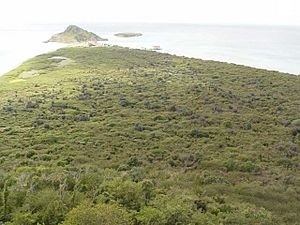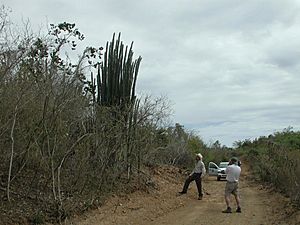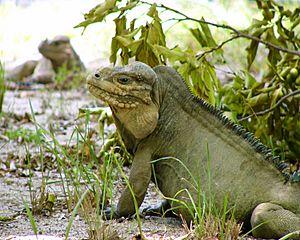Puerto Rican dry forests facts for kids
Quick facts for kids Puerto Rican dry forests |
|
|---|---|
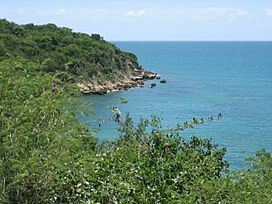
Dry forest in Guánica State Forest
|
|
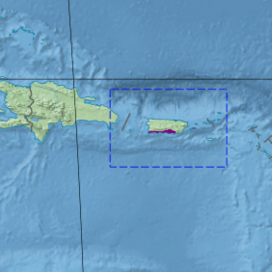
Ecoregion territory (in purple)
|
|
| Ecology | |
| Realm | Neotropic |
| Biome | Tropical and subtropical dry broadleaf forests |
| Borders | Puerto Rican moist forests |
| Geography | |
| Area | 1,159 km2 (447 sq mi) |
| Country | United States |
| Commonwealth | Puerto Rico |
| Conservation | |
| Conservation status | Critical/Endangered |
| Protected | 196 km² (17%) |
The Puerto Rican dry forests are special places found in southwestern and eastern Puerto Rico. They also exist on several smaller islands nearby. These forests are a type of tropical dry forest. They cover about 1,300 square kilometers (500 square miles).
These forests grow in areas that get less than 1,000 millimeters (39 inches) of rain each year. Many trees in these forests are deciduous. This means they lose their leaves during the dry season. The dry season usually lasts from December to April.
Contents
Where are the Dry Forests?
These dry forests are found in two main areas on the island of Puerto Rico. One area is along the south coast. This part of the island is in a "rain shadow." This means the central mountains block the rain. The other area is in the northeastern corner near Fajardo. Here, low elevation and strong ocean winds create a dry environment.
Dry forests also grow on nearby islands. These include Culebra, Mona, Monito, Desecheo, Caja de Muertos, Cayo Santiago, and most of Vieques. The dry forests along the south coast stretch for 120 kilometers (75 miles). They go from Guayama in the east to Cabo Rojo in the west. They also reach 3 to 20 kilometers (2 to 12 miles) inland from the coast.
What is the Climate Like?
The climate in these dry forests changes with the seasons. Most of the rain falls between May and November. The average rainfall on the south coast is between 600 and 1,000 millimeters (24 to 39 inches) per year.
Amazing Plants and Animals
Puerto Rican dry forests have short trees, usually less than 5 meters (16 feet) tall. Many of these trees have multiple stems. The main layer of trees stays green most of the time. However, taller trees that stick out above the main layer often lose their leaves in the dry season.
Types of Plants in the Forest
The types of plants you find depend on how much water is in the soil. This is affected by how deep the soil is and the slope of the land. Near the coast, you can find mangrove trees, salt flats, and beach bushes. Further inland, scrub forests grow on exposed limestone. Deeper soils support forests where trees lose their leaves. Taller, semi-evergreen forests grow in wetter spots.
How much a tree loses its leaves depends on how dry it is. In wetter years, trees keep more leaves. In drier years, they lose more. Even in forests where trees usually lose their leaves, many trees stay green all year.
Cool Plants You Might See
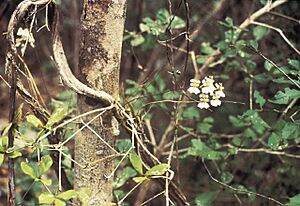
The Puerto Rican dry forests have many plants from the Rubiaceae, Euphorbiaceae, and Myrtaceae families. This is similar to dry forests in Jamaica. However, it is different from dry forests in South and Central America. Those forests have more plants from the Fabaceae and Bignoniaceae families.
Some common trees in coastal dry forests include Guaiacum officinale, Coccoloba venosa, Ceiba pentandra, and Capparis cynophallophora. In dry limestone forests, you might see Pisonia albida, Guaiacum sanctum, and Plumeria alba. Trichilia triacantha is a very rare tree. It is only found in the dry forest area of southwestern Puerto Rico.
Animals of the Dry Forest
The Puerto Rican dry forest is home to many different birds. In Guánica Forest, 185 bird species have been seen. This includes 15 species that live nowhere else in the world. The endangered Puerto Rican nightjar lives only in dry and moist forests in southwestern Puerto Rico. The Puerto Rican crested toad is the only native toad in Puerto Rico. It is known from just one population in Guánica Forest.
Thirteen types of lizards live in the southern dry forests. Two types of anole lizards are found only in this dry forest zone. These are Anolis poncensis and Anolis cooki. The Mona ground iguana lives only in the dry forest on Mona Island.
Some mammals that are not native to the area also live here. These include rhesus macaques and patas monkeys. They can cause problems for farms. The Javan mongoose was brought to Puerto Rico in the 1870s.
Protecting the Dry Forests
Most of the forest was cut down for agriculture before the 1940s. But some parts of the original forest still exist. Areas that were used for making charcoal or for fence posts have grown back quickly. After 50 years, these forests looked just like much older forests.
Also, large areas of new forest have grown on old farmland. These forests on abandoned farms have fewer types of plants and animals than natural forests. It is not clear how long it will take for them to fully recover.
The best example of dry forests in Puerto Rico is the Guánica State Forest (Bosque Estatal de Guánica). It is near the town of Guánica. Most studies about dry forests have happened here. Other protected dry forests in Puerto Rico include the Cabo Rojo, Culebra, Desecheo, and Vieques wildlife refuges. These are part of the Caribbean Islands National Wildlife Refuge Complex. Other protected areas are the Caja de Muertos and the Mona and Monito Islands Natural Reserves. There are also smaller protected areas along the southern coast.
See also
 In Spanish: Bosques secos de Puerto Rico para niños
In Spanish: Bosques secos de Puerto Rico para niños
- List of ecoregions in the United States (WWF)


